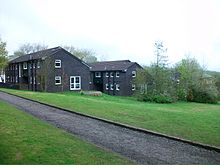

An approved school was a type of residential institution in the United Kingdom to which young people could be sent by a court, usually for committing offences but sometimes because they were deemed to be beyond parental control. They were modelled on ordinary boarding schools, from which it was relatively easy to leave without permission. This set approved schools apart from borstals, a tougher and more enclosed kind of youth prison.
The term came into general use in 1933[1] when approved schools were created out of the earlier "industrial" and "reformatory" schools.[2] Following the Children and Young Persons Act 1969, they were replaced by Community Homes, with responsibility devolved to local councils; in Singapore, which by then was no longer under British rule, the term approved schools continued to exist.[3]
- ^ Gear, Gillian Carol (1999). "Industrial Schools in England, 1857-1933" (PDF). University of London Institute of Education. Retrieved 9 April 2016.
- ^ "Children and Young Persons Act 1933, s.79 ff". www.statutelaw.gov.uk. Archived from the original on 5 August 2012 – via archive.today.
- ^ "Children and Young Persons Act 1969 - full text". www.educationengland.org.uk. Archived from the original on 23 November 2019. Retrieved 15 June 2021.